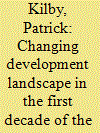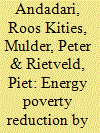| Srl | Item |
| 1 |
ID:
123511


|
|
|
|
|
| Publication |
2012.
|
| Summary/Abstract |
The first decade of the 21st century has been characterised by complex and interrelated changes that have affected development. Development studies as a discipline has traditionally been concerned with the impact of colonisation and neocolonialism, and with neoliberal-related growth models. This paper argues that, since around the turn of the century, there has been a major shift in development, driven by a series of fundamental changes, including the relative failure of the neoliberal project in the 1980s and 1990s, which by the 2000s was partly replaced by a greater concern with addressing security issues with aid; the rise of China and other middle-income countries as large resource providers for development; and the rapid increase of remittance flows to lower and middle income countries. The paper looks at how both development studies and aid policy in Australia and elsewhere have been relatively slow to engage with this rapidly changing context. The big challenges for development studies will be: engaging with developing countries as development donors with different agendas for development; the decline of much of the current neoliberal paradigm; alternative sources of development finance; and the securitisation of Western aid.
|
|
|
|
|
|
|
|
|
|
|
|
|
|
|
|
| 2 |
ID:
128000


|
|
|
|
|
| Publication |
2014.
|
| Summary/Abstract |
In low- and middle-income countries, Liquefied Petroleum Gas (LPG) can be an attractive alternative to the widespread use of traditional kerosene. Not only is LPG a relatively clean, safe and cost-effective fuel for households, its large-scale adoption also reduces the heavy burden of kerosene consumption subsidies on government budgets. Against this background, we evaluate the impact of a large government program to substitute LPG for kerosene in Indonesia. Using a household survey across urban, suburban and rural regions we find that this program was very effective in causing a large scale shift from kerosene to LPG. This shift was positively influenced by level of education, household size and household income. Contradicting the energy-ladder model, the LPG program, reinforced by an increase in the price of kerosene, led to increased stacking of fuels, including increasing consumption of both electricity and traditional biomass. In addition, our analysis shows that the LPG program failed to substantially reduce the overall number of energy-poor people, but it has been effective in alleviating extreme energy-poverty. Finally, we find that medium and higher income households in suburban areas benefitted most from the LPG program.
|
|
|
|
|
|
|
|
|
|
|
|
|
|
|
|